The Frontotemporal Disorders Treatment Market is estimated to be valued at USD 393.5 million in 2025 and is projected to reach USD 616.9 million by 2035, registering a compound annual growth rate (CAGR) of 4.6% over the forecast period.
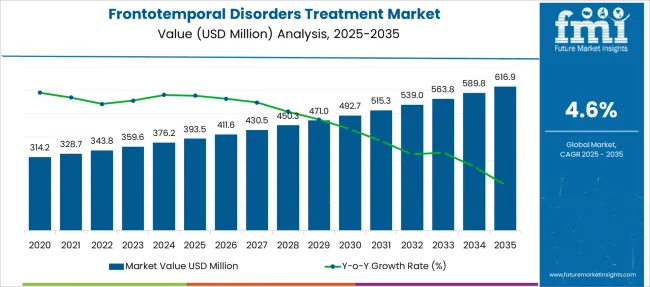
| Metric | Value |
|---|---|
| Frontotemporal Disorders Treatment Market Estimated Value in (2025 E) | USD 393.5 million |
| Frontotemporal Disorders Treatment Market Forecast Value in (2035 F) | USD 616.9 million |
| Forecast CAGR (2025 to 2035) | 4.6% |
The frontotemporal disorders treatment market is experiencing growth due to increased awareness of neurodegenerative conditions and advances in therapeutic approaches. Frontotemporal dementia, the most common subtype, has garnered clinical attention because of its distinctive behavioral and cognitive symptoms.
Healthcare systems are focusing on improving diagnosis and symptom management, which has increased demand for targeted treatments. Behavioral symptoms management has emerged as a key focus area to improve patient quality of life and ease caregiver burden.
Additionally, investments in drug development and multidisciplinary care models have contributed to the market’s expansion. Aging populations worldwide and enhanced clinical recognition of frontotemporal disorders support continued growth. The market outlook remains optimistic with ongoing research into novel therapies and symptomatic care options. Segmental growth is expected to be led by cognitive enhancers, behavioral symptoms management as the primary treatment approach, and frontotemporal dementia as the leading disease indication.
The market is segmented by Drug Class, Treatment, Disease Indication, and Distribution Channel and region. By Drug Class, the market is divided into Cognitive Enhancers, Antipsychotics, Antidepressants, CNS Stimulants, and Others. In terms of Treatment, the market is classified into Behavioral Symptoms Management and Psychological Symptoms Management. Based on Disease Indication, the market is segmented into Frontotemporal Dementia, Primary Progressive Aphasia, and Movement Disorders. By Distribution Channel, the market is divided into Hospital Pharmacies, Retail Pharmacies, Drug Stores, and Online Pharmacies. Regionally, the market is classified into North America, Latin America, Western Europe, Eastern Europe, Balkan & Baltic Countries, Russia & Belarus, Central Asia, East Asia, South Asia & Pacific, and the Middle East & Africa.
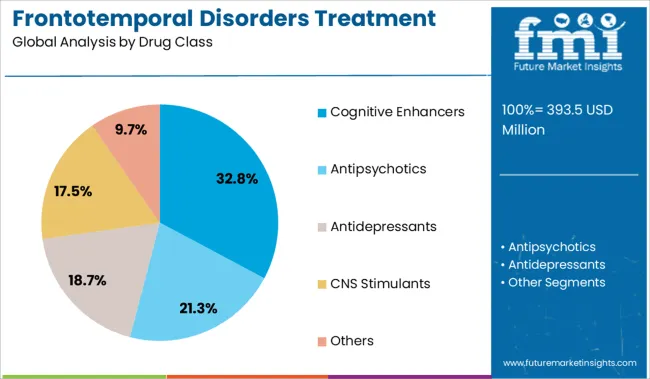
The cognitive enhancers segment is expected to hold 32.8% of the market revenue in 2025, positioning it as a leading drug class. These agents are used to improve cognitive function and slow the progression of symptoms related to frontotemporal disorders. Their adoption has been supported by clinical evidence demonstrating benefits in memory, attention, and executive functions.
Healthcare providers have incorporated cognitive enhancers into comprehensive treatment plans aimed at maintaining patient independence and delaying functional decline. Despite challenges in disease management, the segment continues to grow due to ongoing clinical trials and improved understanding of neurochemical pathways.
As awareness about cognitive health increases, the use of cognitive enhancers in frontotemporal disorders is expected to rise.
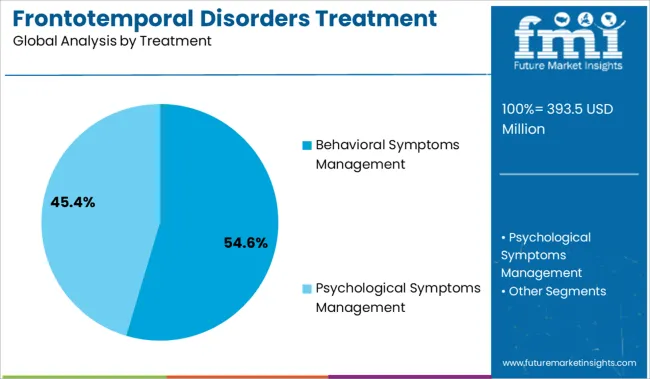
Behavioral symptoms management is projected to contribute 54.6% of the market revenue in 2025, maintaining its position as the primary treatment modality. Managing symptoms such as agitation, apathy, and disinhibition is critical in frontotemporal disorder care to improve patient quality of life.
Pharmacological and non-pharmacological approaches have been employed to address these complex symptoms, with emphasis on individualized care strategies. Clinicians recognize the importance of behavioral management in reducing caregiver stress and delaying institutionalization.
Increased research into effective symptom control has supported the growth of this treatment segment. As patient-centered care models become more widespread, behavioral symptoms management is expected to remain central to treatment protocols.
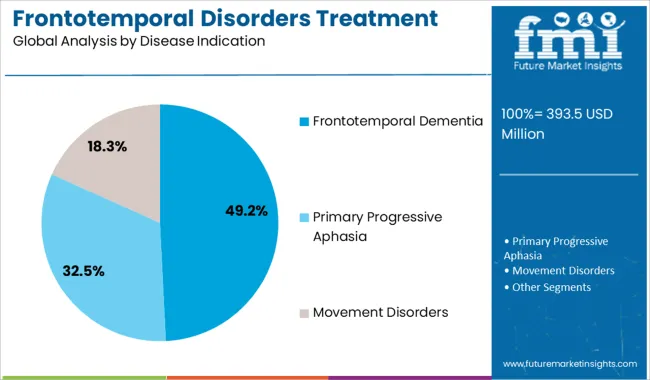
Frontotemporal dementia is anticipated to account for 49.2% of the market revenue in 2025, solidifying its position as the leading disease indication. This subtype is characterized by early onset and distinct behavioral and language impairments, differentiating it from other dementias.
Clinical focus on frontotemporal dementia has increased due to its substantial impact on patients and caregivers. Improved diagnostic techniques and greater clinical awareness have led to more accurate case identification.
Treatment strategies targeting frontotemporal dementia aim to slow symptom progression and improve daily functioning. With an aging population and rising recognition of this disorder, the frontotemporal dementia segment is expected to maintain its dominance in the treatment market.
| Particulars | Details |
|---|---|
| H1, 2024 | 4.69% |
| H1, 2025 Projected | 4.64% |
| H1, 2025 Outlook | 4.44% |
| BPS Change - H1, 2025 (O) - H1, 2025 (P) | (-) 20 ↓ |
| BPS Change - H1, 2025 (O) - H1, 2024 | (-) 25 ↓ |
As per the FMI analysis, H1-2025 outlook period in comparison to H1-2025 projected period showed a negative growth in terms of Basis Point Share by 20 BPS. However, In H1-2025, the market growth rate of frontotemporal disorders treatment is expected to fall by 25 basis point share (BPS).
The decline in the BPS values observed was attributed the fact that there exist no current disease-modifying drugs approved by the regulatory bodies for the treatment of frontotemporal disorders. With growing changes in lifestyle, and the growing global burden of disease in ageing population, the market faced a heavy demand over the last few decades. With a large gap in the demand and supply, the market likely observed this decline in the BPS values.
Conversely, with advancements in behavioural therapy approaches, the management of symptomatic concerns regarding frontotemporal disorders will provide insights into the growth of the overall market during the forecast years.
The market is highly influenced by patient pool, treatment adoption rate, target population group demography, and disease prevalence, under the impact of macro and industry factors.
Growing Prevalence of Dementia Expected to Propel Demand for Frontotemporal Disorders Treatment Drugs
During the historical period of 2013 to 2024, the frontotemporal disorders treatment market expanded at a CAGR of 4.4%.
Frontotemporal disorders are a bunch of rare disorders that include shrinkage of a particular portion of the brain that controls personality, language, and behavior. The condition arises due to the degeneration of frontotemporal cells, which is called frontotemporal lobar degeneration (FTLD).
The typical age range for the onset of frontotemporal dementia is 40 to 60 years; however, it can start after 60 years of age, and the maximum life expectancy after diagnosis is 8-10 years.
With severe dearth of frontotemporal disorders treatment drugs for the reliable treatment of frontotemporal disorders, treatment continues to underscore the growing significance of disease management. As frontotemporal disorders treatment exclusively includes symptomatic efforts to date, the condition continues to attract research interests worldwide.
Available frontotemporal disorders treatment drugs and other means of frontotemporal disorders treatment do not stop or even decelerate frontotemporal disorders progression, which further remains a key driving force for growing demand for frontotemporal disorders treatment. Expanding incentives for orphan drug development is identified as a prominent factor pushing revenue growth of the frontotemporal disorders treatment industry.
Considering the aforementioned factors, the global frontotemporal disorders treatment market is anticipated to rise at 4.6% CAGR across the 2025 to 2035 time frame.
Increasing FTD Drug Development Grants & Funding by Non-Profit Organizations Driving Market Growth
Non-profit organizations and disease advocacy & private organizations currently are focusing on supporting FTD drug development as the patient base of FTD is expanding. Research funding initiatives by non-profit organizations such as the Association for Frontotemporal Degeneration (AFTD), Alzheimer Discovery Foundation (ADDF), Bluefield Project Organization, Tau Consortium Organization, and CurePSP, Inc. have helped promote research initiatives in frontotemporal disorders treatment drugs.
These organizations support clinical trials as well as preclinical studies for testing new therapeutics that are interventional to slow or stop FTD and other rare neurological disease progressions.
Rising life expectancy rate is another major factor expected to boost the growth of the frontotemporal disorders treatment market due to the high prevalence of neurological disease among the older population. Population aged 65 years and above is mostly prone to neurodegenerative diseases such as frontotemporal disorder, Alzheimer’s, and dementia.
Misdiagnosis and Lack of Awareness Limiting Adoption of Neurological Conditions Treatment
Frontotemporal disorders are often misdiagnosed as depression, Parkinson’s, Alzheimer’s, or other psychiatric conditions, thereby limiting the scope of adoption of neurological conditions treatment.
Though clinical trials have resulted in many interventions other than medication, consistently high rate of clinical trial failures is a significant factor that is influencing the growth prospects of neurological conditions treatment.
Ongoing Clinical Trials for Frontotemporal Lobar Degeneration (FTLD) to Boost Market Expansion in Western Europe
Western Europe is expected to contribute 30.5% share in the global frontotemporal disorders treatment market in 2025.
While rapidly growing FTD prevalence and expanding ongoing clinical trials platforms are providing a collective push to the frontotemporal disorders treatment market in Western Europe, research estimates rapid emergence owing to increasing sophistication of the healthcare sector and gradually surging awareness about frontotemporal lobar degeneration (FTLD).
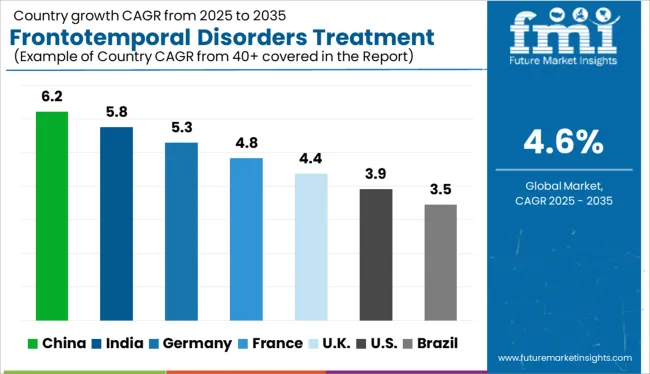
Orphan Drug Development Incentives by FDA to Push the Market Forward
Frontotemporal dementia falls under rare diseases or orphan indications. FTD affects around 30,000 to 40,000 patients in the USA Treatment of FTD falls under auspices of the Orphan Drug Act of 1983 as orphan drug indications are those that affect less than 200,000 people in the USA .
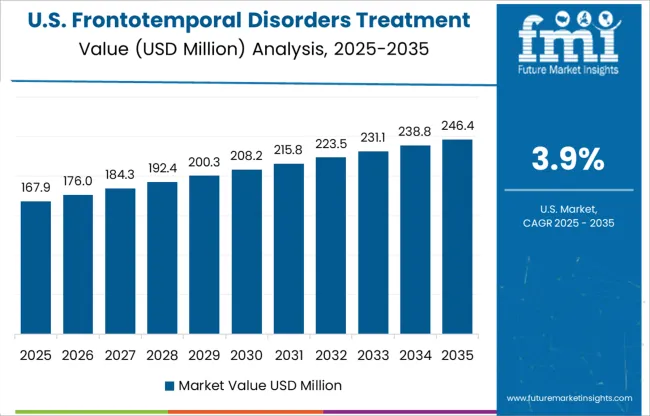
Orphan drug designation to FTD allows the continuation of clinical trial and orphan drug development with commercial incentives, prioritized consultation by FDA on clinical studies, and reduction in regulatory fees.
Presence of advanced healthcare facilities, stronger purchasing power for expensive pharmaceuticals, reimbursement regulations, and an expanding patient pool is expected to fuel market growth in the USA .
Higher Prevalence of Frontotemporal Disorders in Older Age Group to Fuel Market Expansion
China, with an attractive revenue contribution at present, is projected to remain a highly lucrative regional market for potential investors in the frontotemporal disorders treatment systems market.
The market in China is predicted to develop at the quickest rate due to increased disposable income. Moreover, the market growth is related to increasing prevalence of frontotemporal disorders due to the growing elderly population base, as well as the poor immune system.
Initiatives by Mental Treatment Centers for Frontotemporal Dementia Patients to Boost Market Growth
Based on disease indication, frontotemporal dementia (FTD), holding a massive market value share, remains the most common indication among all that continues to capture clinical research interests.
Rapid development of new frontotemporal dementia therapies will push collaborative activities among clinical research entities, educational institutions, academic laboratories, pharma and biotech centers, and the FDA.
Furthermore, frontotemporal dementia therapeutics are anticipated to witness major contributions from pharmaceutical companies - eventually boosting the funding and clinical trial scenario.
Hospital Pharmacies Most Preferred Due to Easy Availability of Frontotemporal Disorders Treatment Drugs
Hospital pharmacies are expected to hold the highest market share over the forecast period. Majority of frontotemporal problems are treated in hospitals, and with the availability of trained medical personnel, it is simpler to control an individual's health more correctly.
However, there are no specific treatments available to entirely stop the course of frontotemporal disorders. As a result, doctors may prescribe antidepressant medicines to help with anxiety and other symptoms.
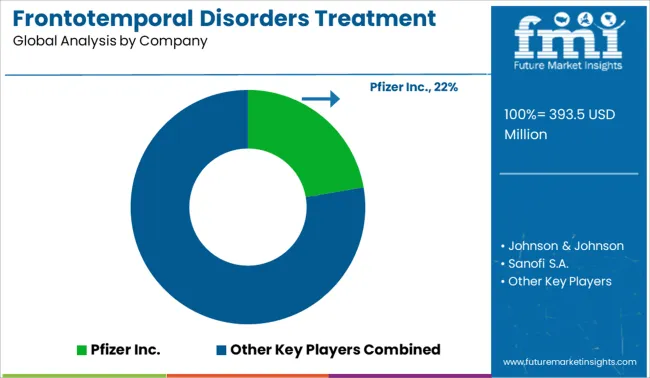
In a highly fragmented landscape of the global frontotemporal disorders treatment market, almost 70% of companies offer generics as their key drug offerings. Operated by a large number of prominent international, multinational, and regional players, the market for frontotemporal disorders treatment is recently witnessing a heap of strategic deals, including acquisitions, collaborations, and alliances.
For instance,
| Attribute | Details |
|---|---|
| Forecast Period | 2025 to 2035 |
| Historical Data Available for | 2013 to 2024 |
| Market Analysis | Value in USD million |
| Key Regions Covered | North America; Latin America; Europe; East Asia; South Asia & Pacific; Middle East & Africa (MEA) |
| Key Countries Covered | USA, Canada, Mexico, Brazil, Mexico, Argentina, Germany, Italy, France, UK, Nordic, Spain, Japan, China, India, Malaysia, Thailand, Australia, GCC Countries, South Africa, Turkey |
| Key Market Segments Covered | Drug Class, Treatment, Disease Indication, Distribution Channel, Region |
| Key Companies Profiled | Pfizer Inc.; Johnson & Johnson; Sanofi S.A.; Eli Lilly and Company; GlaxoSmithKline Plc.; Novartis AG; Mylan N.V.; Merck & Company, Inc.; AstraZeneca plc.; Allergen plc |
| Pricing | Available upon Request |
The global frontotemporal disorders treatment market is estimated to be valued at USD 393.5 million in 2025.
The market size for the frontotemporal disorders treatment market is projected to reach USD 616.9 million by 2035.
The frontotemporal disorders treatment market is expected to grow at a 4.6% CAGR between 2025 and 2035.
The key product types in frontotemporal disorders treatment market are cognitive enhancers, antipsychotics, antidepressants, cns stimulants and others.
In terms of treatment, behavioral symptoms management segment to command 54.6% share in the frontotemporal disorders treatment market in 2025.






Full Research Suite comprises of:
Market outlook & trends analysis
Interviews & case studies
Strategic recommendations
Vendor profiles & capabilities analysis
5-year forecasts
8 regions and 60+ country-level data splits
Market segment data splits
12 months of continuous data updates
DELIVERED AS:
PDF EXCEL ONLINE
Frontotemporal Dementia (FTD) Management Market – Trends & Future Outlook 2025 to 2035
Anxiety Disorders And Depression Treatment Market Size and Share Forecast Outlook 2025 to 2035
Coagulation Disorders Market
Sleep Movement Disorders Market Size and Share Forecast Outlook 2025 to 2035
Amino Acid Metabolism Disorders Treatment Market Growth – Trends & Forecast 2024-2034
Circadian Rhythm Sleep Disorders Market Size and Share Forecast Outlook 2025 to 2035
Inherited Orphan Blood Disorders Therapeutics Market Size and Share Forecast Outlook 2025 to 2035
Lipoprotein Metabolism Disorders Treatment Market
Paediatric Neuropsychiatric Disorders Treatment Market
Nucleic Acid and Gene Therapies in Neuromuscular Disorders Market Size and Share Forecast Outlook 2025 to 2035
Treatment-Resistant Hypertension Management Market Size and Share Forecast Outlook 2025 to 2035
Treatment-Resistant Depression Treatment Market Size and Share Forecast Outlook 2025 to 2035
Treatment Pumps Market Insights Growth & Demand Forecast 2025 to 2035
Pretreatment Coatings Market Size and Share Forecast Outlook 2025 to 2035
Air Treatment Ozone Generator Market Size and Share Forecast Outlook 2025 to 2035
CNS Treatment and Therapy Market Insights - Trends & Growth Forecast 2025 to 2035
Seed Treatment Materials Market Size and Share Forecast Outlook 2025 to 2035
Acne Treatment Solutions Market Size and Share Forecast Outlook 2025 to 2035
Scar Treatment Market Overview - Growth & Demand Forecast 2025 to 2035
Soil Treatment Chemicals Market

Thank you!
You will receive an email from our Business Development Manager. Please be sure to check your SPAM/JUNK folder too.
Chat With
MaRIA